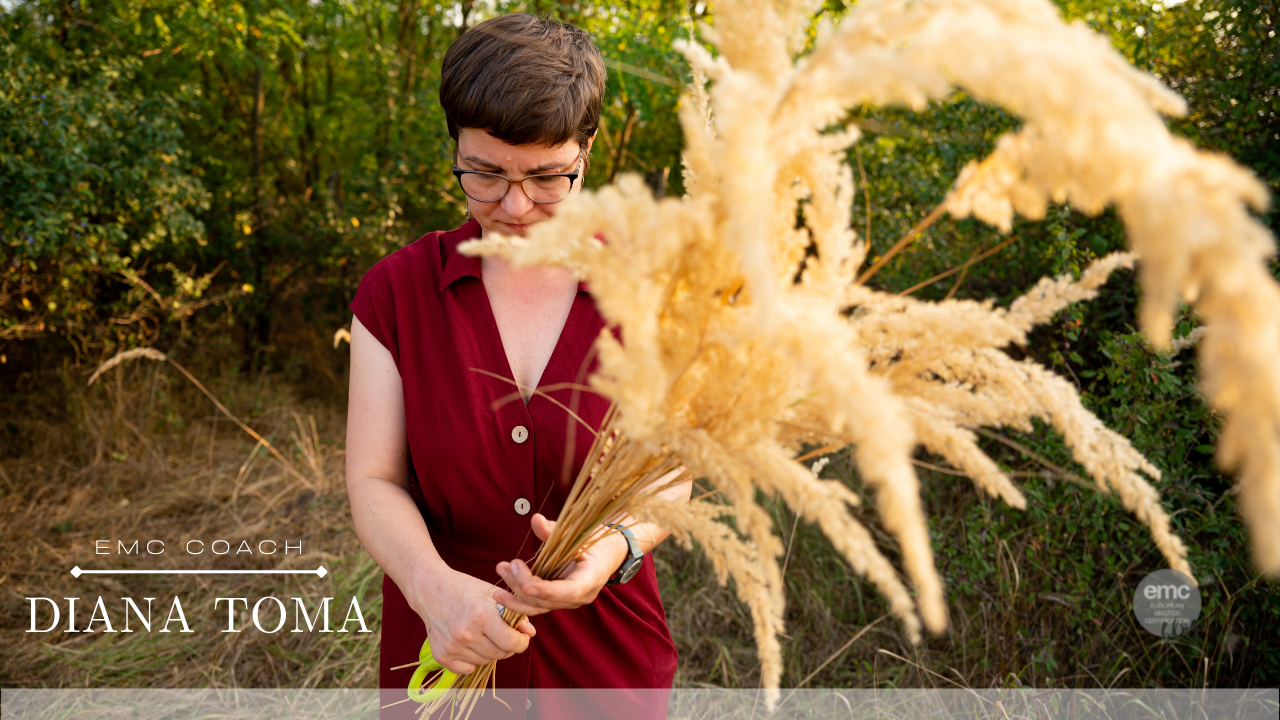
Meet the EMC Team
May 01, 2022"I set myself challenges, intentionally going against my preferences."
Diana Toma, EMC in conversation with Ana Grigoras Cfd EMC
I am part of the EMC team and have been for the past four years. I am a coach in the programme, having students join the Foundation class and go on to the Practicum course, where I help them with their journey and their assignments; and design-wise and with florals, I started about twelve years ago.
Everybody knows that you are a member of the EMC Core team, that you are a teacher and a coach, but I would very much like to know ‘Who is Diana Toma’?
I always say that it wasn’t me finding flowers but the flowers finding me. I worked for about ten years in multinational companies in the telecom industry, involved in retail, customer service and management, until one day I suddenly realised that money wasn’t everything. I was doing a good job, but I had no passion for it. I decided to take a break and I had a friend who worked in a flower shop but who decided to start up a small business on her own, including free-lancing in my local town. I encouraged her to do it and the first time that she went on a free-lancing job, she found that the company was requiring more than she could cope with on her own, including completing eight weddings in one weekend. I got a call from her on the Thursday evening, asking me to go and help because there was no way that she could do it on her own. I was free at that time with no obligations, so I went along to help her, thinking I would be brushing the floor, cleaning up after her and just giving support to a friend. However, she had a very different idea. She wanted me to watch what she was doing, copy it exactly and carry on making twenty-five more of the same arrangement! That is how it all began.
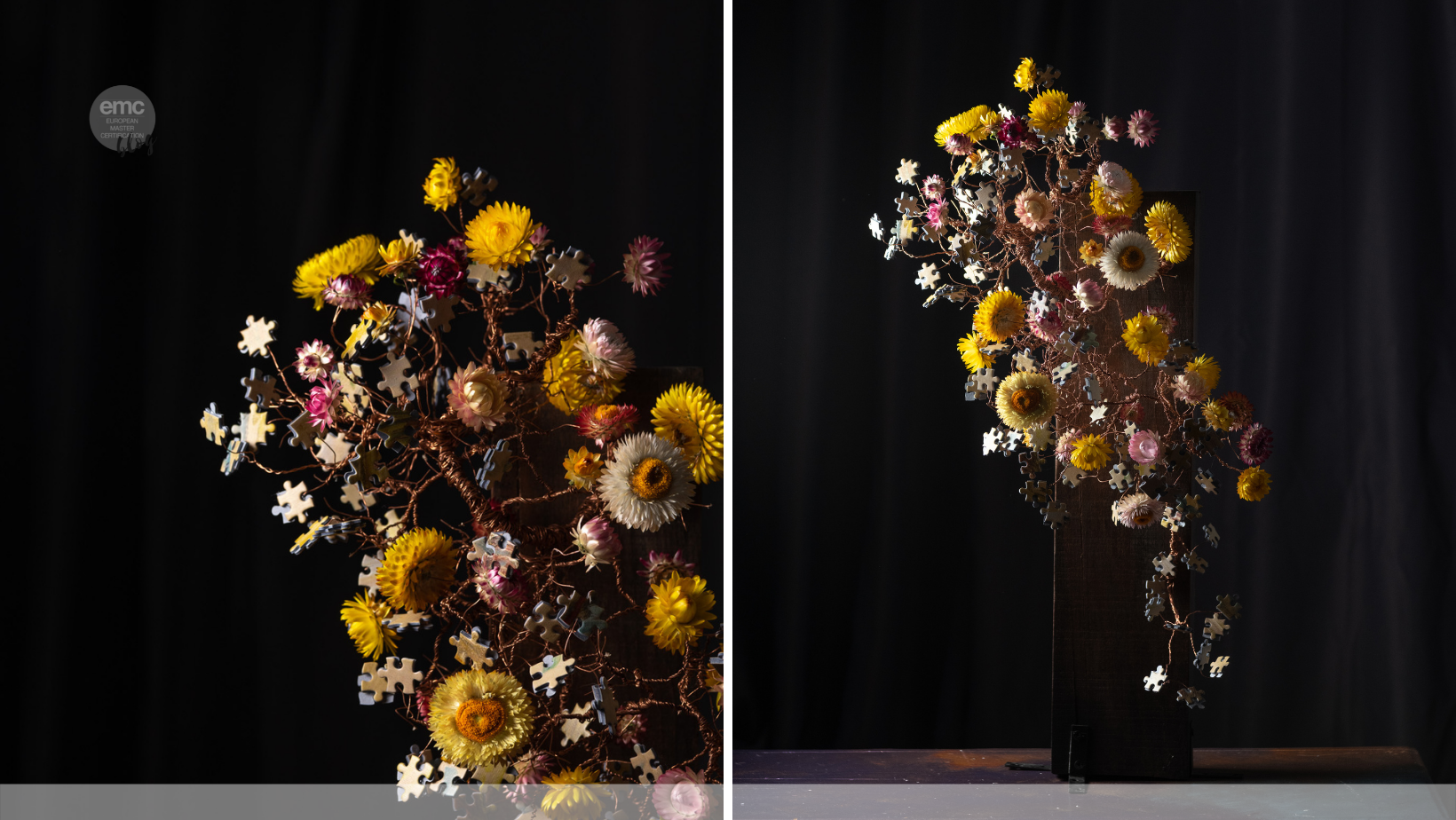 From then, I worked with her over the next six months, loved what I was doing, and we decided to start up a business together, doing a lot of weddings in our local area and it was enough work for us. This went on for a few years, with me dropping in and out as my lifestyle changed, with getting married and having two children. When my second child was old enough, I had a conversation with my husband as I felt that it was the time to become serious about what I wanted to do and get a floral education. In the meantime, my friend had moved to Germany, and I was on my own so I could make my own personal decisions. That is when I joined the EMC programme. I was a student with EMC and then I graduated, and my life changed completely. I kept on doing some weddings, but in a different way; and then I moved to the educational side, joining the EMC team and now my work is very different. I do not consider myself a superstar type of florist but, importantly, I have not lost my floral passion. I believe that this passion will remain with me for the rest of my life, and I will never retire from floristry – I do not want to stop!
From then, I worked with her over the next six months, loved what I was doing, and we decided to start up a business together, doing a lot of weddings in our local area and it was enough work for us. This went on for a few years, with me dropping in and out as my lifestyle changed, with getting married and having two children. When my second child was old enough, I had a conversation with my husband as I felt that it was the time to become serious about what I wanted to do and get a floral education. In the meantime, my friend had moved to Germany, and I was on my own so I could make my own personal decisions. That is when I joined the EMC programme. I was a student with EMC and then I graduated, and my life changed completely. I kept on doing some weddings, but in a different way; and then I moved to the educational side, joining the EMC team and now my work is very different. I do not consider myself a superstar type of florist but, importantly, I have not lost my floral passion. I believe that this passion will remain with me for the rest of my life, and I will never retire from floristry – I do not want to stop! Do you feel that with this passion it seems that this is not just a job, it is a way of life for you?
I feel that it is important to understand that the creativity and passion for floristry as a job. You must consider the hours that you put into it, the work that has to be done and how you are being paid for it. We know that the idea that people have that you ‘enjoy playing with flowers’ isn’t the real truth – floristry is a very hard, dirty, heavy job, but at the end of the day it is the passion that I have that drives me to do what I do. I am continually evaluating what I do, trying to take myself forward, find where I want my career to go, and I am now in a place where I have my freedom and control over what I do, although the job and the hours can be very hard, but my passion continues to drive me forward. It is always important to take the next step, challenge yourself and get out of the comfort zone.
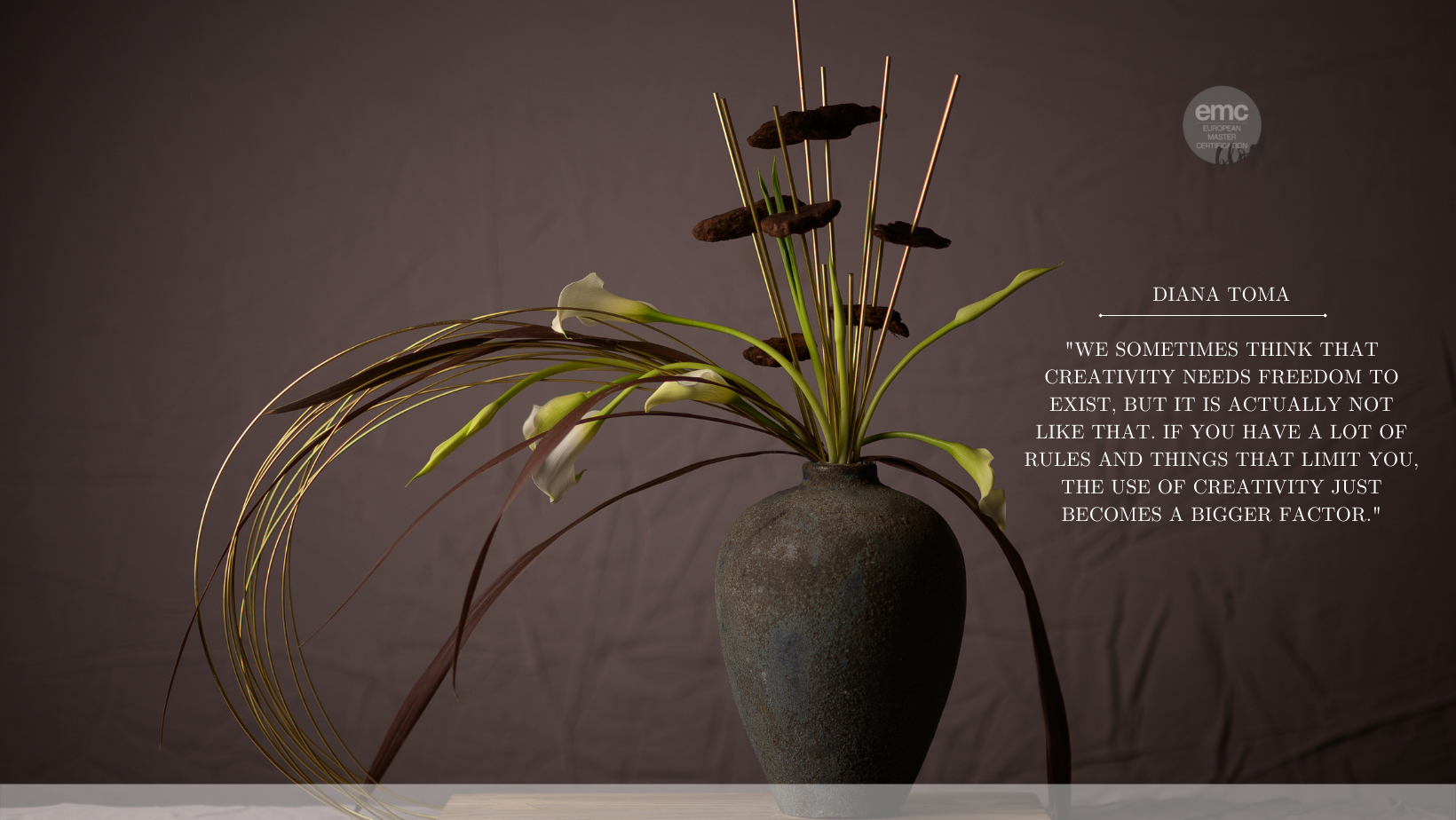
When you are so busy doing work that is so demanding of your time and creative energy, do you sometimes feel that you want to create something just for yourself, as though it is almost a hobby? Is this your time for experimentation? Over the years that I have known you, I have seen how your creative work has changed and developed, and I am interested to know more about this. I feel that you are now working with a smaller number of botanicals but are using the few with which you do work to create something that makes a form of creative statement, with the full focus on the one type of flower. I am curious to know what created this shift.
In a sense, I am just exploring what I can do, to possibly call it my signature style. When I look back at my social media posts, I have shifted my style a lot. One of the reasons is that I no longer do the weddings and little commercial events. I used to do local weddings and I was focussing on the client and what they wanted. As you know, in EMC we use the W’s, and we must design for the client.
There are several aspects that have brought about the change, one of them being that I have now stopped doing the weddings. Also, the family and I have now moved to live in Belgium but before that happened, I lived in a remote, rural part of Romania. Buying flowers on a regular basis was no longer an option as it didn’t make sense – I didn’t have a shop, I didn’t have events for which I was working, so I didn’t need that amount of flowers. I started a lot of local foraging, as Romania has a rich wealth of different botanicals everywhere. For about two and a half years, I did regular morning walks with my dogs and looking for what I could forage. It was not that I was always collecting material, but I was looking at different botanicals, where and what I might be able to collect and use, how it grows, giving myself ideas of what could be created from it and how. Because of these two factors, I had to move my design ideas to using less variety of botanicals but using them to greater effect. I have never been afraid of exploring challenges in a sense because I am passionate about what I do and that helps. It has been quite enjoyable to do this shift in creative design. It was quite interesting to try to get this shift over on social media and for people to understand the difference. I now work with a very limited number of botanicals. It can be one single flower, or several stems of the same flower, because when you forage like that, you can go big, even picking up branches from behind your house to use.

When you are working with only one type of flower, it can be quite challenging because you must think of what type of emotion you want to convey. How do you decide what message you want to give others with this type of design?
Originally it was not too hard, as I was doing it for myself not for customers. I was worried about how people would perceive it when I put the new style of design on social media but, overall, there has been a good reaction. It has changed again now because we have moved from the country to live in the middle of a city, and I do not have the same type of access and ability to forage. It will take some time before I can find my full creative environment again, but I already have my own little corner in which I can experiment and try things out, but not on the same scale as I used to. Circumstances change and we must adapt and make the best of what we have.
We have great changes going on all around us at the moment, with prices going up and shortages of all sorts of things. Do you think that we could all learn from using less variety in our designs but using them more effectively?
This is something that florists around the world are facing. There is a shortage of flowers and prices have gone up, but this is all beyond our control. At the end of the day, your focus is not just on the flowers but more on the design and the emotions you create. If I look at a flower, I don’t just see that it is pretty. For me the flower has all the things that I have learnt about in EMC. You have the character, you have lines, you have transparency, or you don’t have transparency, you have the colour harmonies. Basically, if you take all the elements that you see in one botanical, you play with them and interact with other materials, the mechanics, and you add in the techniques; the design direction is unlimited. We sometimes think that creativity needs freedom to exist, but it is actually not like that. If you have a lot of rules and things that limit you, the use of creativity just becomes a bigger factor. When I consider creativity, I always think of architects. Some of the most wonderful buildings have been designed by architects functioning within a very strict set of rules. When an architect takes on a job, he first has to consider the law of the city or place, all the safe and healthy aspects and the facilities needed, so many rules and legislation to be considered and yet you see the most amazing constructions that come through, despite all these creative constraints. If you are certain that you have that infinite potential of being creative, it shouldn’t matter how many rules or how many challenges come, because they are not meant to stop you. They just become a boost to your inner creativity. I am hoping that designers will learn to look beyond a big pile of beautiful flowers and design with fewer, flowers are perfect in their own right and each one should be seen to its fullest extent, as it is in nature. After all, supermarkets have learnt that flowers will sell themselves. If you want to sell a design with the emotion and added value, that is a completely different story.
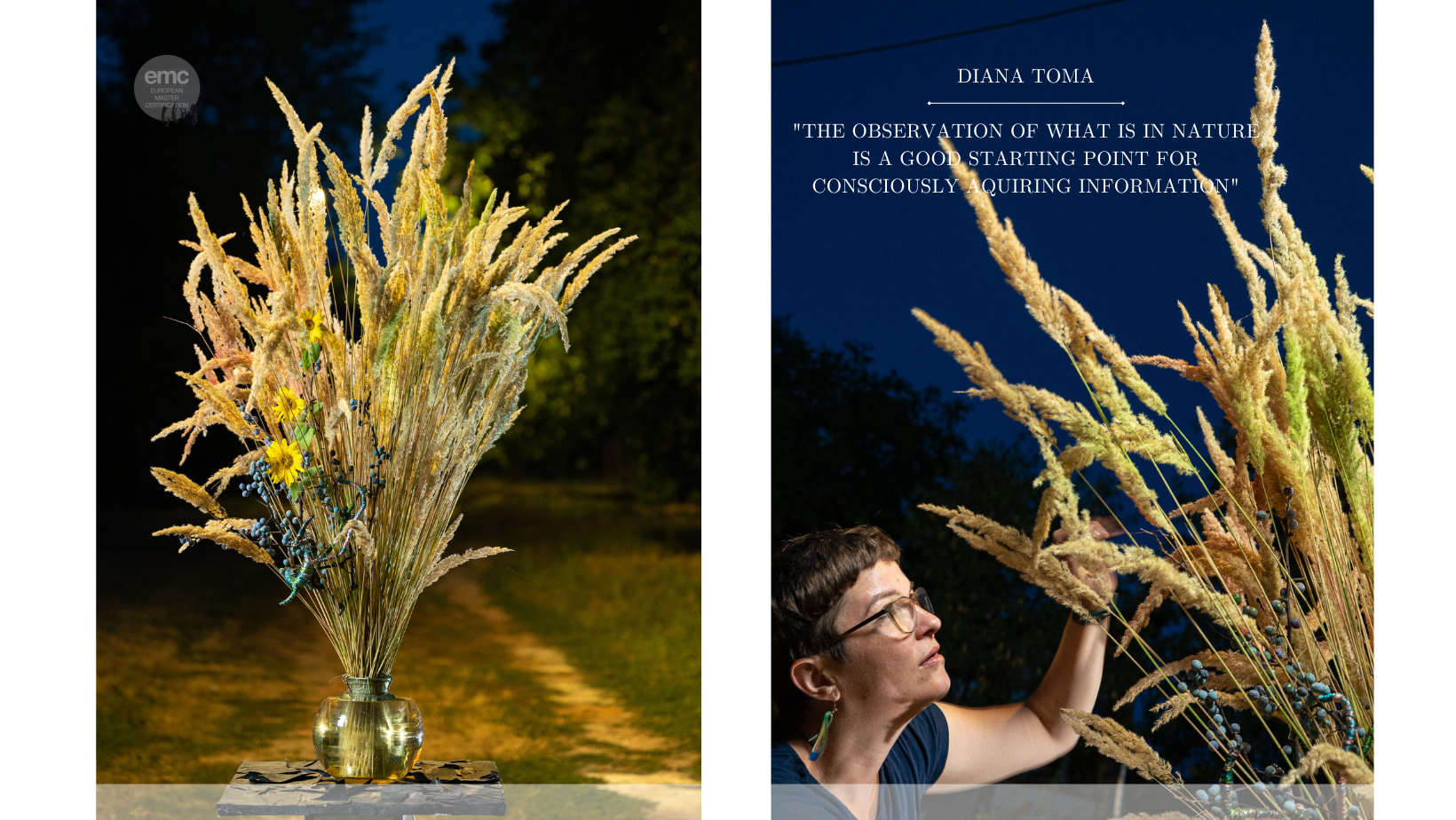
Do you think that a knowledge of nomenclature is useful in this style of designing when you have a limited number of flowers?
Having gone through the process of completing the nomenclature assignment myself in the Practicum stage, and now from the other side having seen students sitting the exam, I realise how easy it can become for those who have an education in horticulture and science. It has a huge impact on your knowledge, and I know that I am not a nomenclature expert, but I can use that knowledge. For me the most important thing that I have learnt from working towards the exam is that I have built a system of research on botanicals, which I can still refer to easily. It is there for me if I need an insight into a botanical because I cannot remember everything, and it does help as it makes me more aware of the medium with which I work. I have also realised that using the Latin names shows clients that you have a real knowledge of what you are speaking about, and they will understand you, with the assistance of images and mood boards. Even when I free-lance with projects around the world, I may not speak the language, but I can recognise the genus and am able to discuss the flowers with the local florists. I am also now free-lancing in Belgium in a local flower shop and the price list shows the genus in Latin while all the rest of the name and further details are written in Dutch, so at least I have a beginning from which I can start! Although I cannot, as yet explain totally the importance to me of nomenclature in what I do now, but I know that it definitely helps me in many ways.
Do you think that as we had to study all the botanicals, not just flowers but also foliages and plants, that it has made us more aware of what there is surrounding us? There are times when we can look at a certain type of branch or some berries and they can help us to produce something interesting.
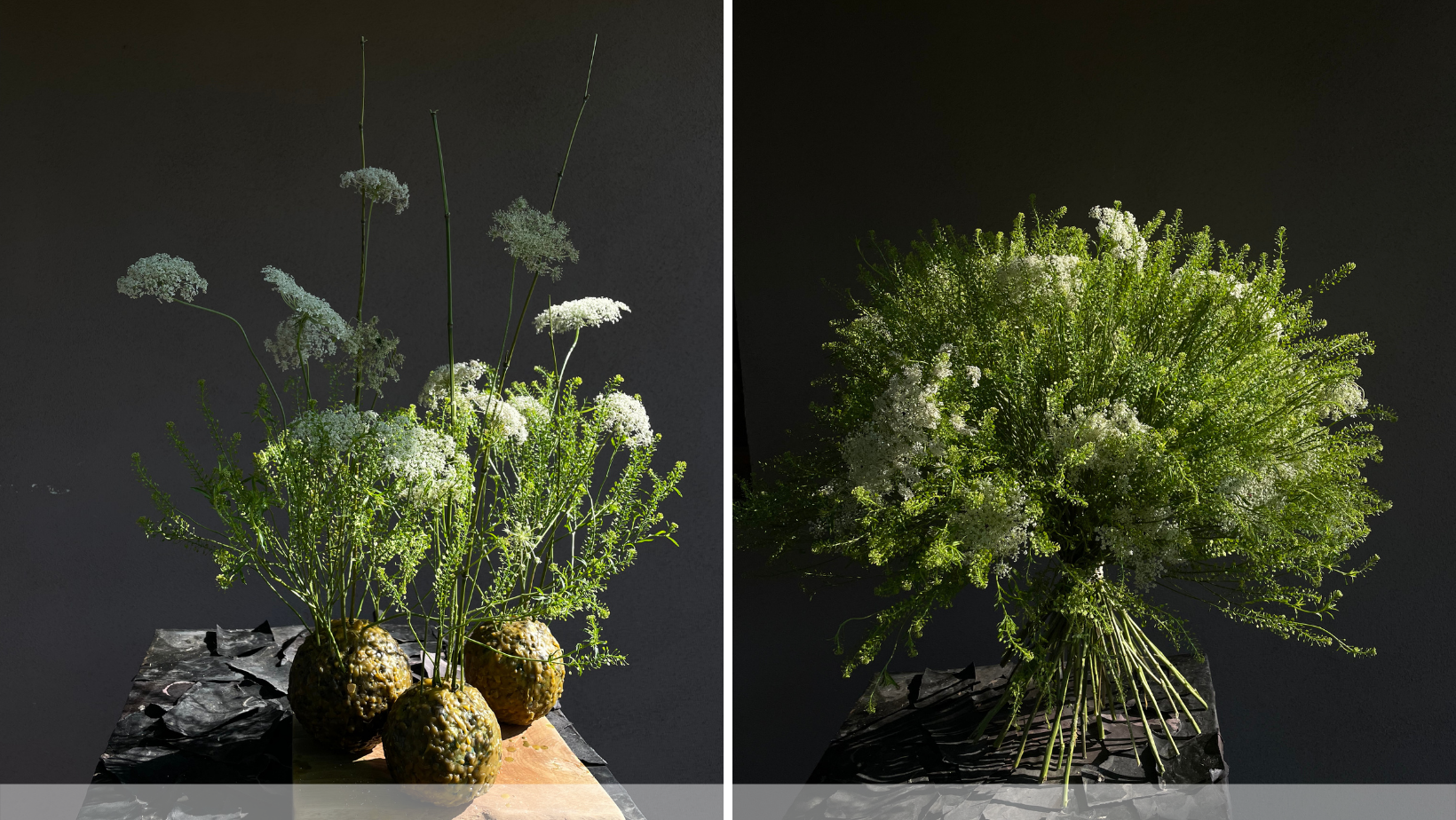
It has made me more aware of what is around me and what is important, but all the elements and principles of design come into it too, along with the nomenclature, and they join together. I think the observation of what is in nature is a starting point for information, looking at how nature works, or how to even copy what is happening. Whatever design style you approach, you still have to see what is happening in nature. Looking at a tree, you still have to be able to see beyond the fact that it is a pretty tree. You have to see the proportions within it. If a branch is broken by a strong wind, you still need to see how and why it was broken and to see the effect on the proportions and the way it grows. All those little things add up and you learn from them. Although I no longer go out walking with the dogs, I still look at nature. Even when I go out in the car, but not when I am driving, I look at what is growing around me, the nature and I take photos with my phone, so that I have a two-dimensional image from which I get ideas. It is also why we do the challenges, because looking through the lens of the camera can give a totally different impression of your design. Quite often, you will finish a design and be quite pleased with it but when you take a photo, you look at it and you see things that are wrong with it.
You do more with photography now, don’t you?
I know that I have taken photos and not been very happy with them and realised that it was much better to have a professional photographer taking them. It is not always possible to afford a professional photographer and I decided to learn more about it, like a project to be completed. I decided that I must try to do this, and I am lucky to have a very good friend who is a really good photographer. Whenever I was with him working on a project, I would ask him what he was doing and why he was doing it. Ultimately, I learnt quite a lot by trial and error and I realised that it is another art form and a lot of it I already know for floral design, and I can apply it to photography. I had to figure out some technicalities, but it has improved my photography and also even my design work. I often do a design, take a photograph, and realise where I need to improve or change it. It may be not too bad, but it is not the outcome that I am looking for.
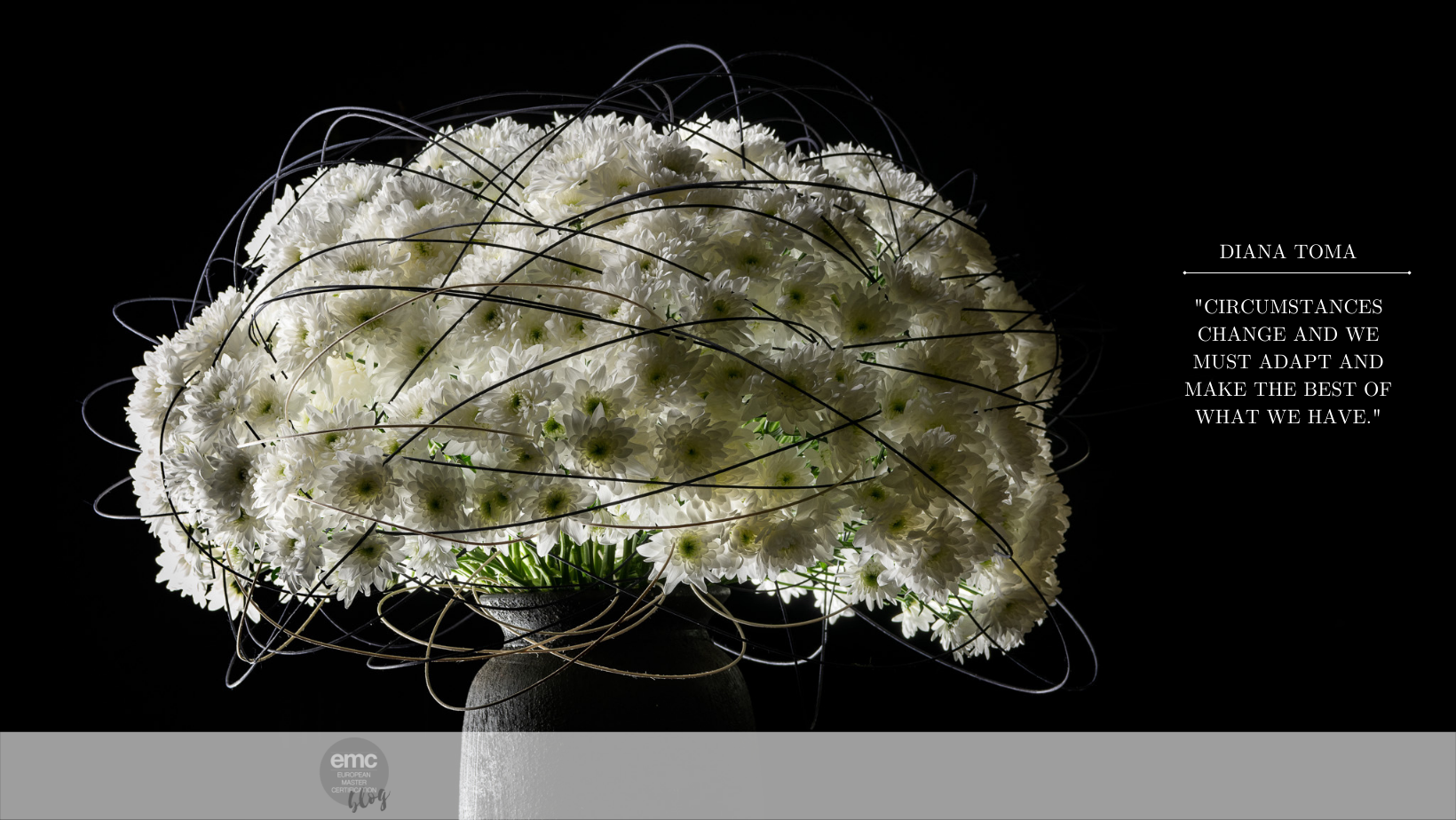
When you do a design, where do you start from? Do you do sketches, do you do just imagine it, do you envisage it in your mind?
I always go back to my W’s. If it is a commercial job for a client, then a whole set of other things come into place, and I have to investigate who my client is, and what is the mood in order to deliver what is wanted. I do not do a sketch, but I will do a mood board and go from there. It is very unusual to have a client who says ‘do whatever you want’ – that is very rare. For me it is very important when I am doing my own work, to keep putting myself in that position where I create and explore my ability. Sometimes I set myself challenges, especially those that go against my own nature. For instance, when I did my wedding work, I never used Gypsophila. Where I used to live in Romania, we lived very close to the border with Hungary and a lot of local growers grew it and it was very cheap. All the wedding designers in the city and the events designers all used lots of Gypsophila. For me, it was just a cheap filler flower. When I started to see challenges online where Gypsophila had to be used, I took part to challenge myself, as it was not something that I would usually use, and I did it to help myself grow. Over a period of time, I made a lot of structures and a lot of decorative arrangements, because that specific style was very close to my heart. So now I am moving away from that and the ideas that I have are far from that. Sometimes, my objective is to explore new techniques or uses for mechanics. My husband used to have a workshop where he worked with wood, so I would find the leftover pieces and I would always try to incorporate that into my designs and that would be the purpose. Sometimes, I can take quite a long time to work with it but other times, I will not have much time in which to complete the design so I will need to envisage it beforehand. If I have more time, I may play with the designs and experiment more and that is why I want the freedom to do that. If I have to design and complete within a certain time, that is totally different. I feel that this experimentation has also helped me with my clients, because I am more confident in what I can do.
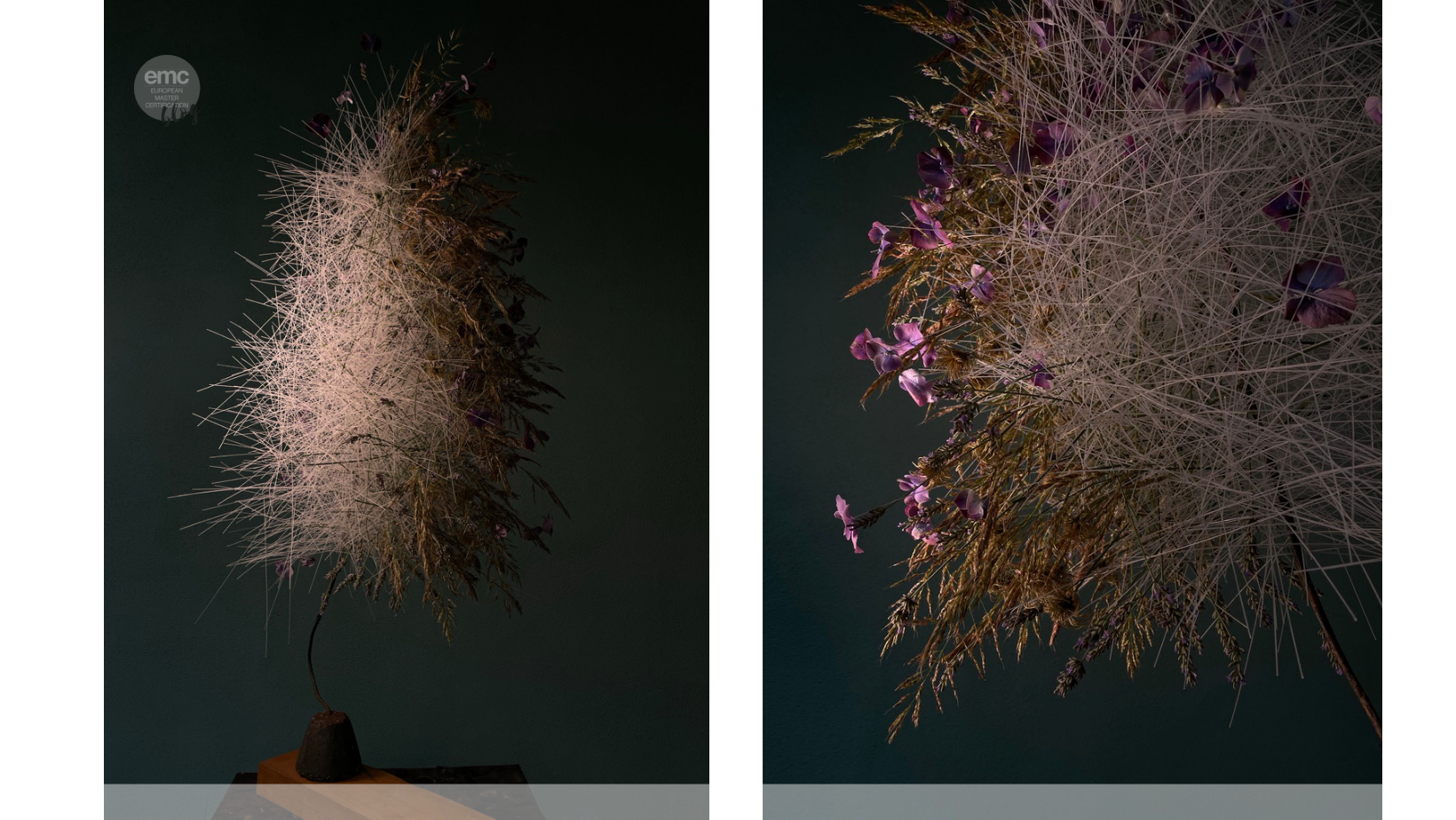
So, do you feel that your work is now split between the floral art to express yourself through the media, and floral design with a purpose and functionality for the client?
Sometimes I am conscious that I am just designing for a photo, and I may not spend a lot of time finessing everything or worrying about transportation, but even when I am just designing for a picture, I do consider what I might have done differently if it was for a client, just in case somebody would actually ask for this design. I do tend to be aware of the differences between what I am doing and how it would have to be done differently for a client; what changes would be needed. Sometimes I know that I would have to explain to a client that it couldn’t be done or must be done at the location. When you talk of being a conscious creative, this is what we mean. We do have to be aware of all the different aspects of what we are doing. Recently, I used tulips in a design which was just to illustrate a play of lines, so I did not use water tubes in the construction. This would not be suitable for a client but worked for a photo, within the context of showing the lines achieved by the tulip stems not being in water
Something that I am aware of as I have a floral studio, not a shop, is the problem of buying multiple bunches of many types of flowers to fulfil orders and being left with flowers that I cannot sell which takes away my profit, so you have to become creative in finding a way of using the leftover flowers. I am thinking that this type of design where you are using less flowers could be a problem solver in this kind of situation. What do you feel?
It can be a problem when you are doing a few orders and have to consider the buying and profit, and this could become an option. In whatever direction you wish to go, you have to find solutions to problems, and this can be the challenging part. These solutions do not fall out of the sky, it is up to you to find them. If you look at the Scandinavian designers, and also in Japan, these are countries where there is a shortage of flowers, and this is not a new experience for them. If you think of Stein Are Hansen and his work, there is not a great deal of flower, and he is a world champion. One of the ways that his designs became like this is that in Norway, flowers are very expensive, so you have to work with what you have, and find the best ways with your creativity to achieve the most from your designs. Our creativity doesn’t have to be limited to just the floral design itself but must be with the business side as well. There is a lot of competition out there. I do feel that, at the end of the day, if you invest in yourself, things will come. Things do not always come when you want them to, but most times good things come when you actually need them to, but you do not always identify it at that time. The focus should be mainly on getting the best out of what you can do and that can only come from the mind, getting an education in your job and in trying to improve yourself all the time.
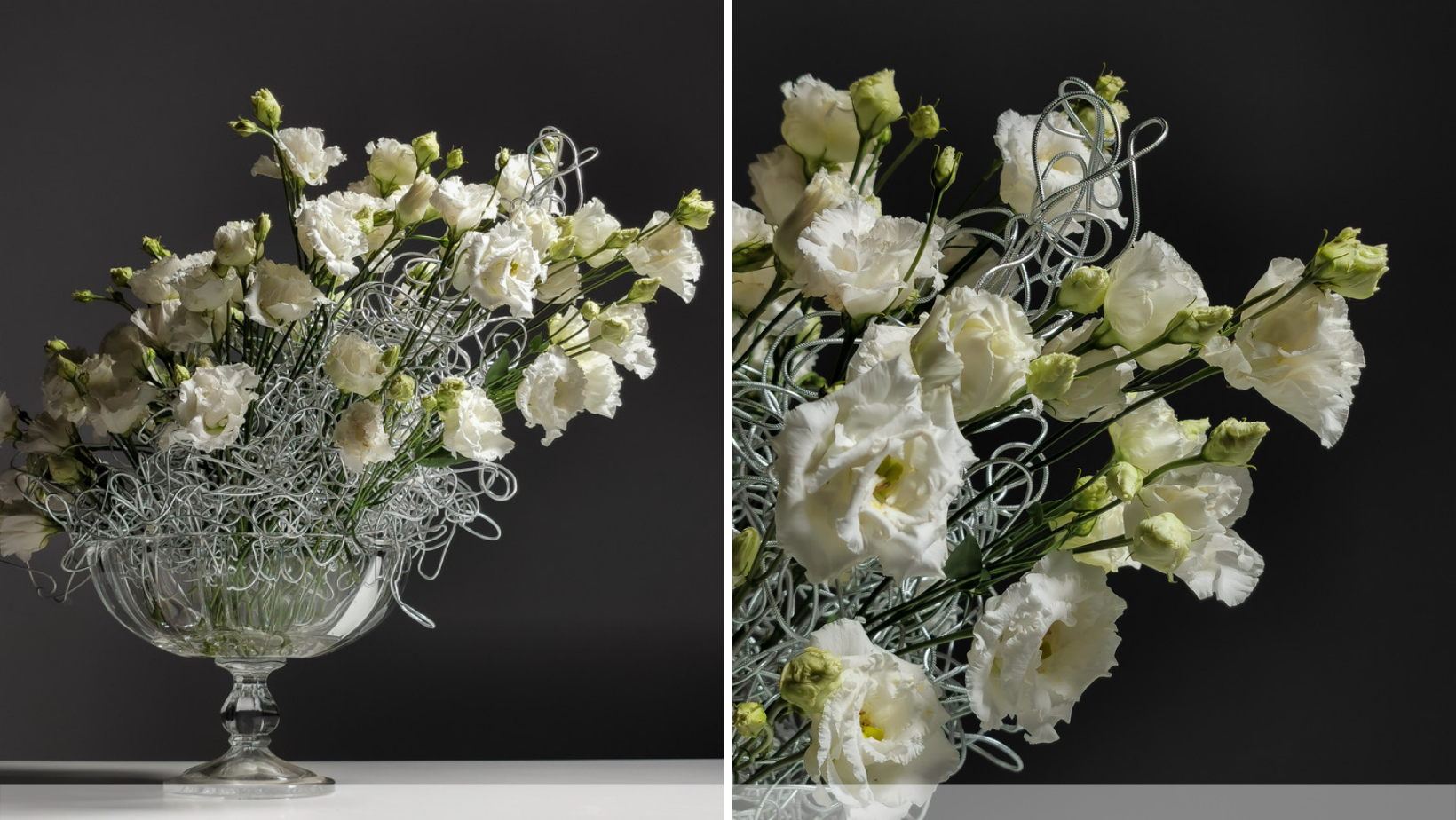
And you think that this will all pay off at some point with your work?
I am not saying that it is going to be easy, but you need to think that way to make it happen. There will be ups and downs, it can be very hard, and you constantly have to deal with things. Whatever you decide to change in your life, whether it is your job or something else, at the end of the day you are not going to have the same problems but there will be different problems; the mindset is very important with the way you invest in yourself, and it is very crucial to the way you move forward.
Define your personality using a maximum of three of the elements and principles of design.
How would I define my personality! Definitely asymmetric, my balance is off a lot of the time, and I don’t think that I will go beyond that as I am definitely asymmetric, meaning that I like things on the edge with some added tension!
If you were a flower what would you be and why?
Oh, that is a good one, I have never thought of that before. I think my chosen flower compliments my personality. I think I would go for a chrysanthemum, as it is resilient. I would like to be that resilient.
What is the one thing that you could not do without when working with flowers?
Tools – I couldn’t do without them. They completely change your life when you discover them.
Don't miss a beat!
New blogs, course offerings and what we are up to delivered to your inbox!
We hate SPAM. We will never sell your information, for any reason.

